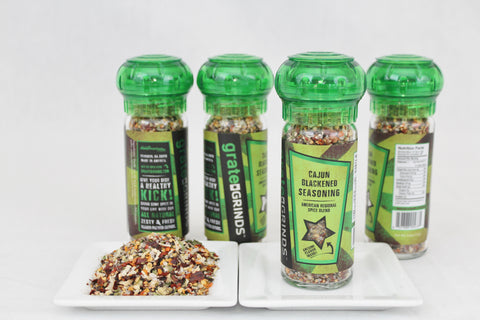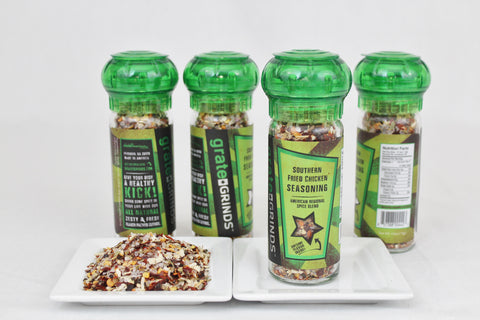Creole Seasoning
Creole Seasoning - This spice blend gives you food the essence of Creole Cuisine. Grind some of this spice mix onto chicken, fish or shrimp before roasting or sautéing or into rice pilaf, Creole Red Beans & Rice, or Creole Jambalaya to give your recipe that burst of Creole flavor.
Share this Product
Creole Seasoning - Creole Cuisine originates from the New Orleans area of Louisiana and is a melding of African, Spanish, French, Caribbean, Portuguese, Italian and American influences. Its rich history dates back to before the first English written cookbooks in 1885. Similar to Cajun Cuisine, which is more rustic, they share the “Holy Trinity” of onions, celery and bell peppers. Grind some of this spice mix onto chicken, fish or shrimp before roasting or sautéing or into rice pilaf, Creole Red Beans & Rice, or Creole Jambalaya to give your recipe that burst of Creole flavor.
Spice ingredients: Pacific Sea salt, garlic, New Mexican green chiles, onions, celery, red bell peppers, crushed red peppers, black and white peppercorns, basil, oregano and thyme.
Please click on the RECIPE tab for detailed for cooking instructions.
Creole Seasoning is available in a 4 oz. spice grinder bottle.
Creole Seasoning Cooking Instructions - This spice blend gives you food the essence of Creole Cuisine. It can be used on Fish, Chicken, Steaks, Vegetables and Rice.
NOTE: To review and/or select the meat you wish to use, please refer to the "Recommendation Guide to selecting your beef, pork, chicken, turkey or seafood" PDF, located in the Recipe link in the heading at the top of the Home page.
COOKING INSTRUCTIONS
- To use the Creole Seasoning on fish, poultry or meat, spray or rub a lite coating of oil on all sides of the food, then grind an even coating of the Creole Seasoning to your level of flavor on all sides. Press the seasoning into the food lightly to get it to stick. The more you grind on the more of a flavor impact the seasoning will have. Fig. 1 below is an example of how much seasoning to grind onto your food as a general rule. If you like spicy food, grind more on!
- After you have rubbed your meat, refrigerate it and allow the rub to rest on the meat for at least 20 minutes or up to twenty-four hours. The longer the resting period, the more the rub can penetrate the meat.
- To use it on vegetables, prepare your vegetables and place them in a roasting pan or sauté pan and spray a little oil all over them. Then grind the Creole Seasoning evenly all over the vegetable to the flavor level you desire and roast or sauté as you normally would.
- To make Creole seasoned rice, bring your water to a boil in a thick bottomed pan for even heat distribution, add the appropriate amount of rice (long grain white rice = 1 part rice to 1.5 to 1.75 parts water, brown rice = 1 part to 2.5 to 2.75 parts and wild rice = 1 part to 3.5 to 4 parts, respectively), add in 1 teaspoon of Creole Seasoning to the water/rice for each cup of rice. The amount of water varies as the type of rices are all a little different. Some white rices need to be rinsed (in a fine colander or sieve) prior to cooking to remove any excess milling starch left on the rice grains. If not, your rice could be sticky. Give the rice one quick stir. Cover a cook on low for according to your package instructions, undisturbed. General rule is 15 to 18 minutes for white rice, 25 to 30 minutes for brown rice and 40 to 50 minutes for wild rice. Remove your rice from the stove and let rest for 5 to 20 minutes to completely absorb the water and finish cooking. Carryover cooking is taking effect again, as the rice continues to cook after removed from the heat.
NOTE: One word of caution, these rubs are self-contained, meaning that they already have salt in them in the proper ratio to the spices and herbs, so don’t overdo it with grinding the rubs or add any additional salt.

Figure 1. Catfish with Creole Seasoning ready for the sauté pan.
NOTE: Always buy your meats from a quality reputable stores. Keep all meat under refrigeration as much as possible during preparation. Don’t leave any meats out at room temperature for more than 30 minutes, except when you are ready to cook it. Then let it just reach room temperature prior to cooking, but don’t let time exceed an hour. Food safe guidelines recommend that any proteins (meats in this case) are not exposed to the “Temperature Danger Zone” (40 F. to 140 F) for more than 4 hours for its entire journey to you cooking it. We are informing you of these food safety guidelines, because we want you to have a wonderful flavorful safe food experience, every time.
- To sauté your fish, chicken, beef or pork use a solid cast iron pan, if you have one (they hold the heat evenly very well) large enough to comfortably fit the food you are cooking or cook it in batches. Using medium heat, preheat the pan until it's hot. If you have an exhaust fan as part of your kitchen, turn it on now.
- Carefully add a few tablespoons of oil to the pan and immediately and gently place the seasoned fish, beef, pork, chicken or vegetables in the cast iron pan. The food will begin to sizzle and sear. Leave it in one place for half of the cooking time and then gently flip it over to complete the cooking on the other side. Part of the trick to a properly sautéed piece of food is to leave the food in the pan without moving it around. This allows for a good crust to form. For a piece of catfish, as shown above, the cooking time on each side could be a little as 3 to 4 minutes per side. When you see the edges all the way around the fish turn white, then turn it over.
- As a reminder, the term "sauté" literally translates to "jump in the pan". So when you place your food in the sauté pan, it should sizzle! This is the sound of flavor, as you sear a crust on your meat. This also adds another texture and seals in the juices in the meat.

Figure 2. Catfish, peppers and onions cooking in the pan.
NOTE: Chicken and turkey should reach 165 F. Fish and pork should be cooked to 145 F. Beef should be cooked to your personal preference of doneness. If you are looking for a specific temperature of doneness, use this BEEF general temperature guide: 125 F. for rare, 130 F. for medium rare, 135 F. for medium, 140 F. for medium well and over 150 F. for well done.
- Once you feel your food has reached the proper temperature, remove it from the pan and let it "rest" under a foil tent on a plate. There is an activity that takes place now called “carryover cooking”. Once your food is removed from the heat source, it will continue to cook for a few minutes for smaller pieces of food. The retained heat in the meat continues the cooking process for a few more minutes, as the meat cools down. Part of the resting period is to allow the internal liquids in the meat, which are forced to the center by the intense cooking heat, and it will take a few minutes for the liquids to redistribute themselves throughout the meat.

Figure 3. Pan fried Catfish with Creole Seasoning.
 PROUDLY MADE IN AMERICA
PROUDLY MADE IN AMERICA







